Having enjoyed a springtime foraging trip with Tudor Farmhouse a couple of years ago, I decided to buy Mr Skylark a foraging experience for his most recent birthday present. Autumn seemed the perfect time to book it, as we both liked the idea of foraging for mushrooms.
We headed to Tudor Farmhouse on a Saturday morning in November. This small, boutique hotel is located in the village of Clearwell in the Forest of Dean. As we got into the area of the Forest, it was lovely to see the trees cloaked in myriad shades of burnished gold.
While hotel residents were enjoying their leisurely breakfasts, we huddled around a table with cups of coffee, waiting for the rest of our group to arrive. Our enthusiastic group of 10 came from as far a field as Kent and as near as Stroud. Everyone seemed keen to learn as much as possible from our expert guide, Mr Raoul van den Broucke.
I’d already told Mr Skylark what a colourful character Raoul is. In his 70s, he has accumulated an absolute wealth of knowledge about foraging in the wild. He grew up in Belgium, learning to hunt for edible plants and fungi from his grandmother. He then spent 20 years in Portugal running a business exporting mushrooms to the likes of Antonio Carluccio (who could apparently be a tricky customer). It’s not hard to see why Raoul himself has been described as the ‘Carluccio of the Wye Valley.’ As for the rest of his life’s experiences, I’ll leave you to ask him yourself, although I did suggest he should write his memoirs.
Our first port of call was the hotel’s car park. Raoul pointed out fennel, peeking out amongst the autumn berries. There were two types, one bronze and one green. It had a really strong smell of aniseed and is the perfect herb to accompany fish.
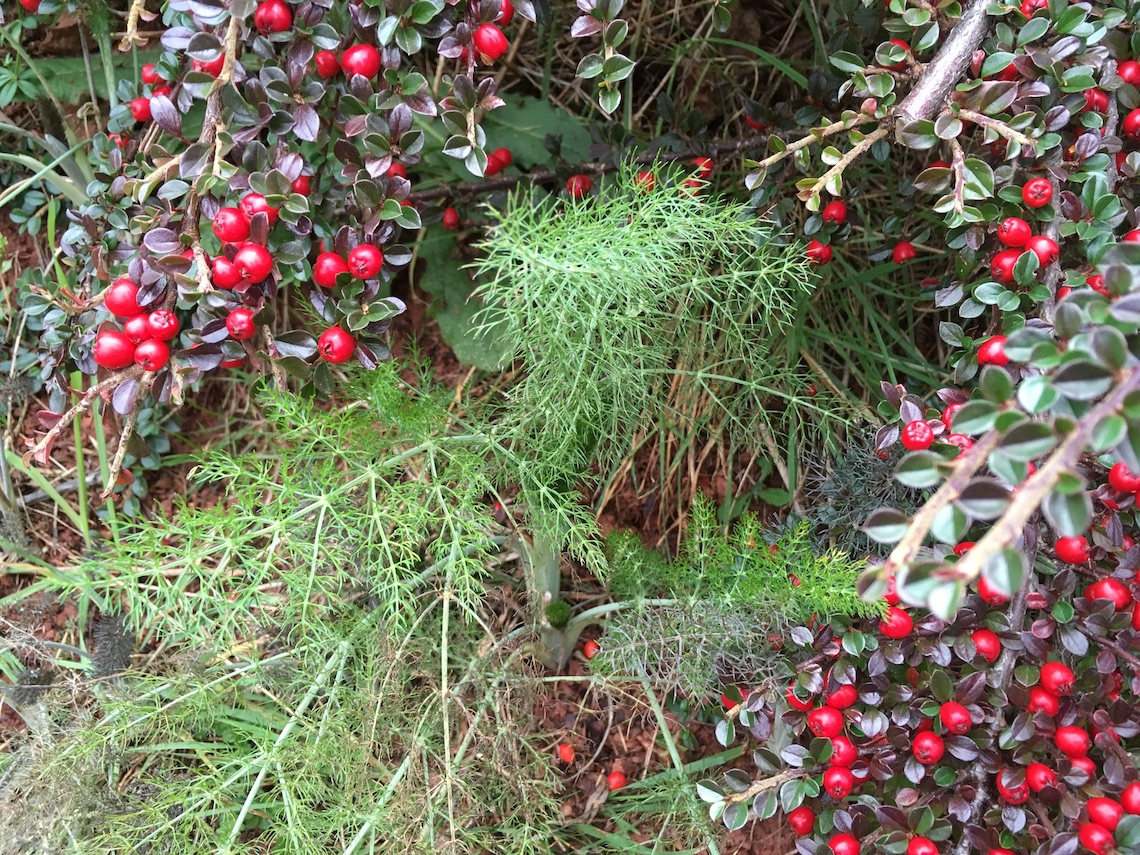
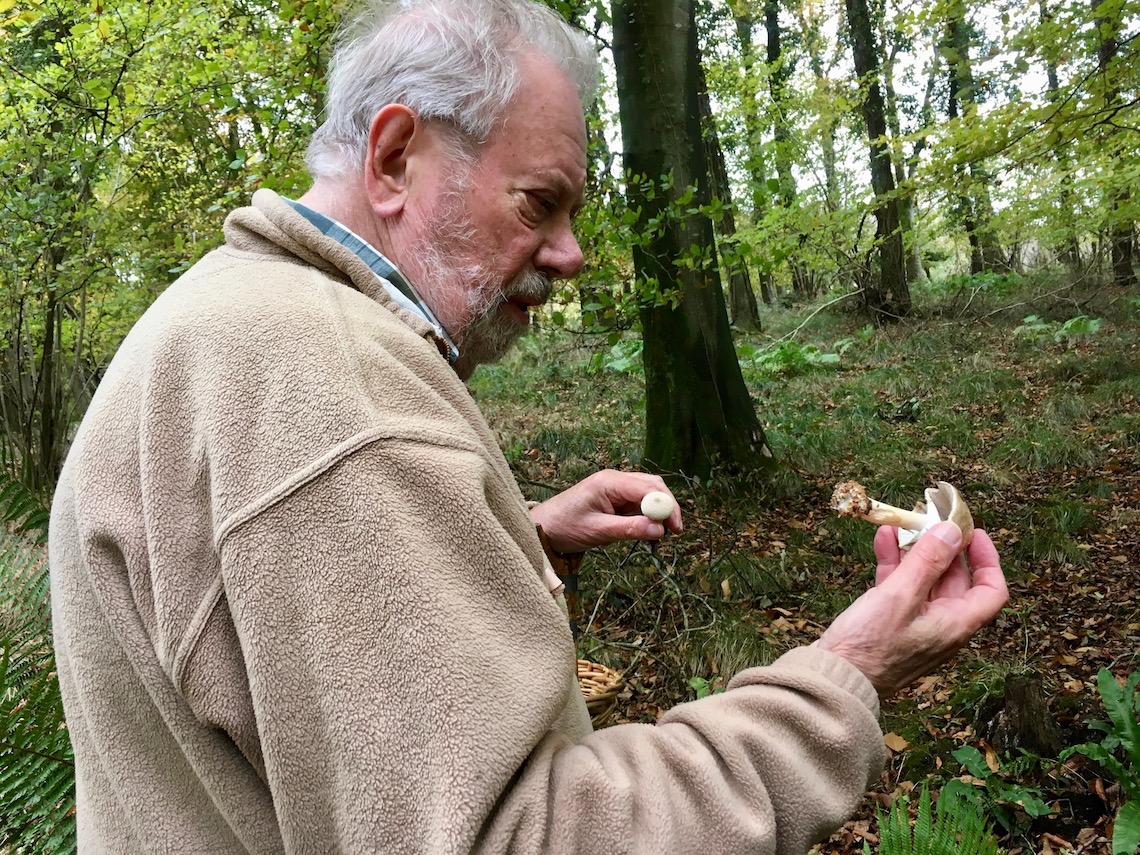
Mushroom Foraging in the Forest of Dean
We car-shared to cover the short distances around the area for our foraging expedition. Mr Skylark and I were lucky to accompany Raoul. It gave us a chance to pick his brains. Mr Skylark told him about the field mushrooms he’d picked as a child, and we mentioned some fungi we’d spotted on various woodland walks, but were too scared to pick. Raoul warned us, “The rule about picking mushrooms is there are no rules.” However he did recommend the book, ‘Mushrooms,’ by Roger Philips, before suggesting, “If you want to learn, learn slowly. Focus on one mushroom each year.”
Parking at the edge of woodland, we trudged up a leafy path. Raoul pointed out a fallen branch. Peeking out from underneath was a delicate group of frilly, cream coloured mushrooms, shaded in ripples of brown. These turkey tail mushrooms are the edible kind and are said to have amazing immune boosting properties. Our expert guide explained that mushrooms found on deciduous trees are more likely to be edible. “Don’t touch mushrooms on pine or conifer trees,” he advised.
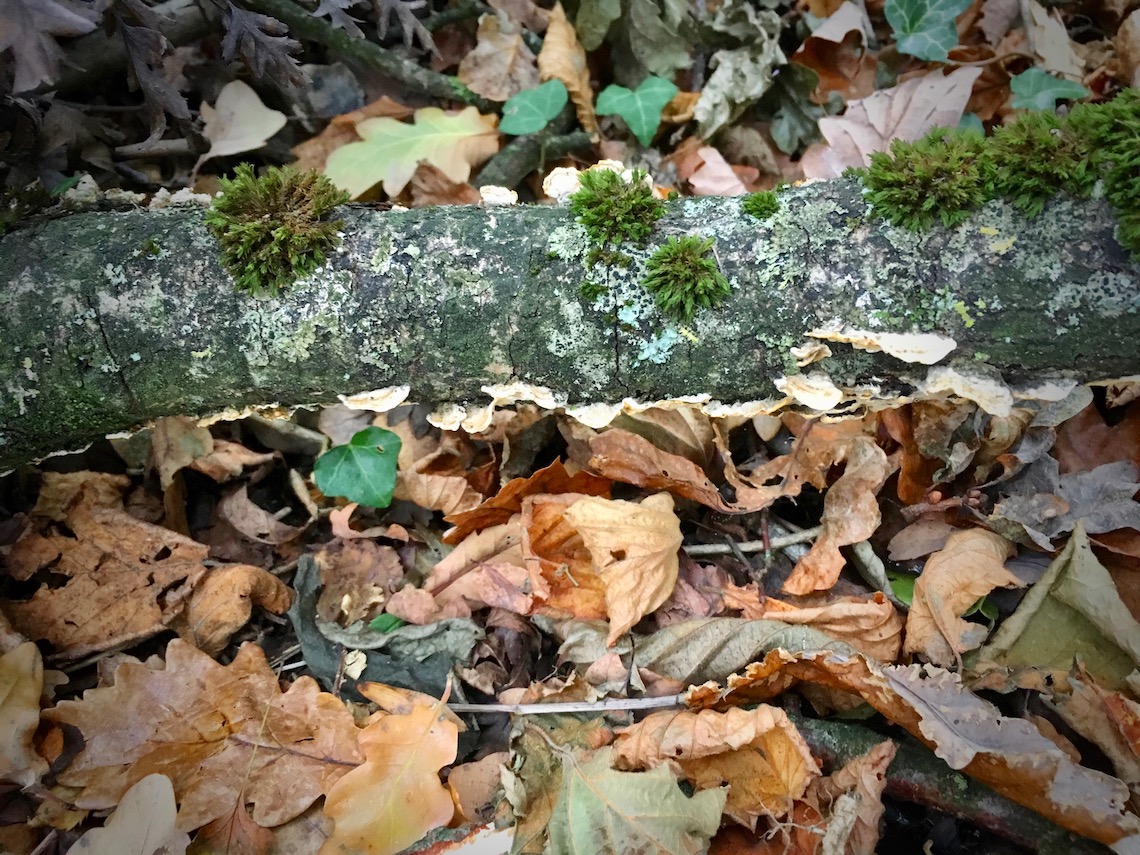
We bumped into a group of walkers with a very springy spaniel. They were friends of Raoul’s and joked about him getting lost in the woods. It turned out this has happened to him before. It’s easy to get so distracted by mushroom hunting on the forest floor, that you get a bit disoriented by your surroundings.
The first mushroom Raoul put into his wicker basket was a puffball – a small one, not the giant kind. It had a smooth, pale, beige cap covered in little spikes. There were no gills underneath. He passed it around the group for a sniff. It had a lovely earthy smell. He cut it in half to confirm it was definitely a puffball. The inside was soft, spongy and almost white. If the inside has started to turn yellow, it indicates a more mature puffball, which can make you sick.
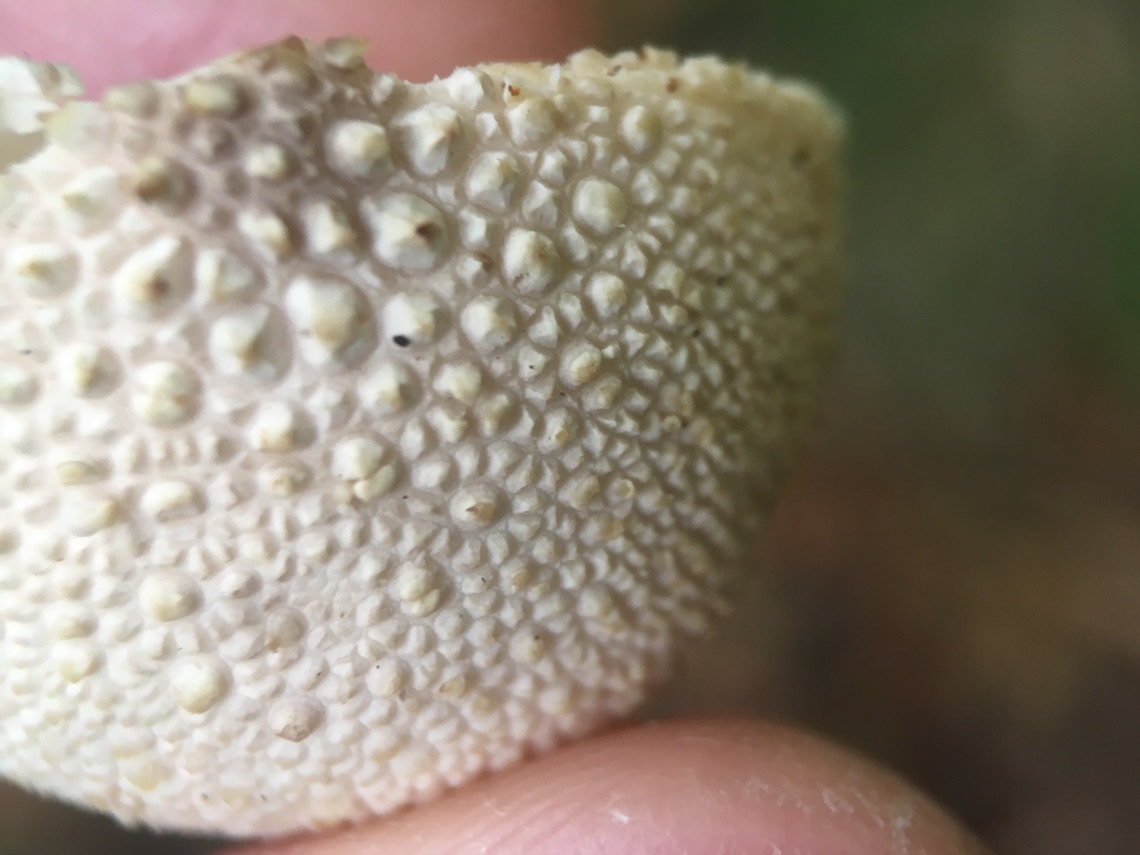
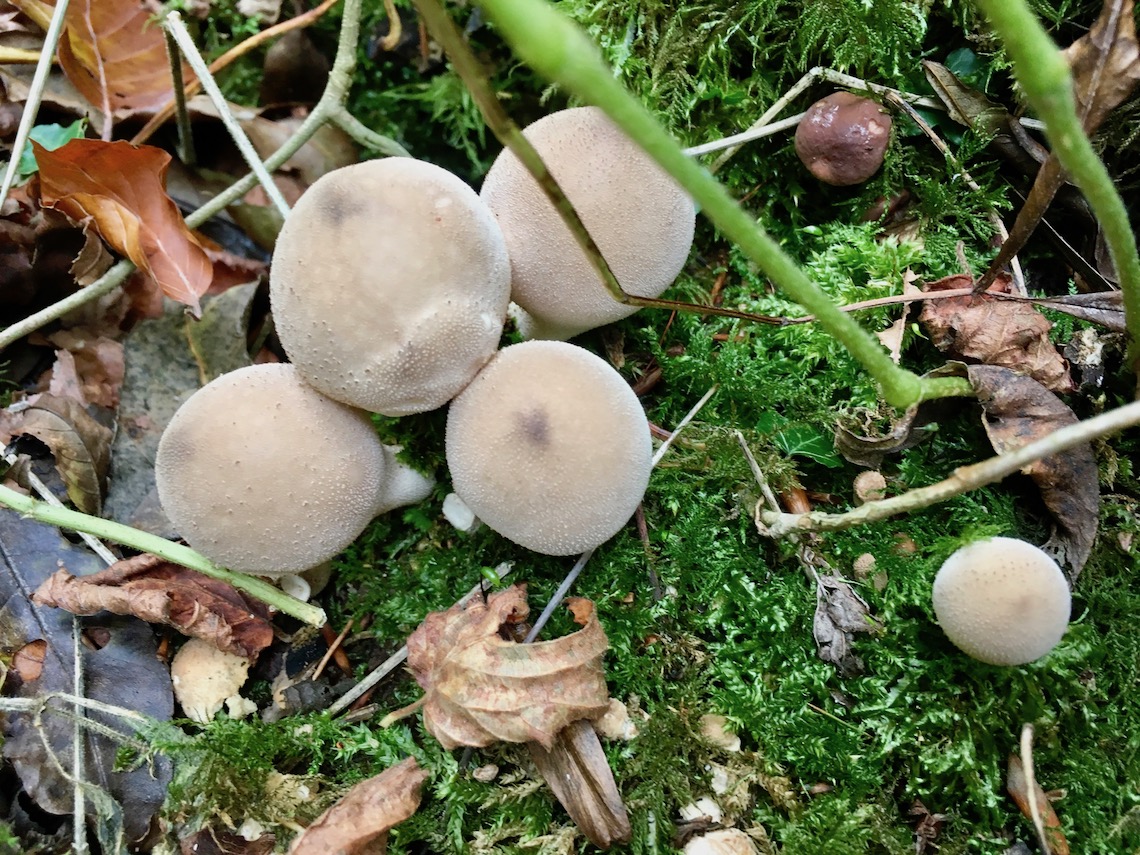
Our group started scouting around in the leaf litter for mushrooms. Every so often, someone would approach Raoul with a carefully picked fungus. His usual response was, “No good” and he’d toss it aside. Even if mushrooms are technically edible, we learned most of them don’t have much flavour so they are not worth bothering with. Our guide repeated his mantra, “The rule about mushrooms is there are no rules.”
Raoul found us some clouded agaric to add to the basket. This pale, grey-brown, mottled mushroom has very pale cream gills underneath. He said the gills must be pale cream if they are to be eaten. I have since read that clouded agaric can cause stomach upsets, so I guess this proves the point that you should only pick them if you are accompanied by an expert mushroom guide.
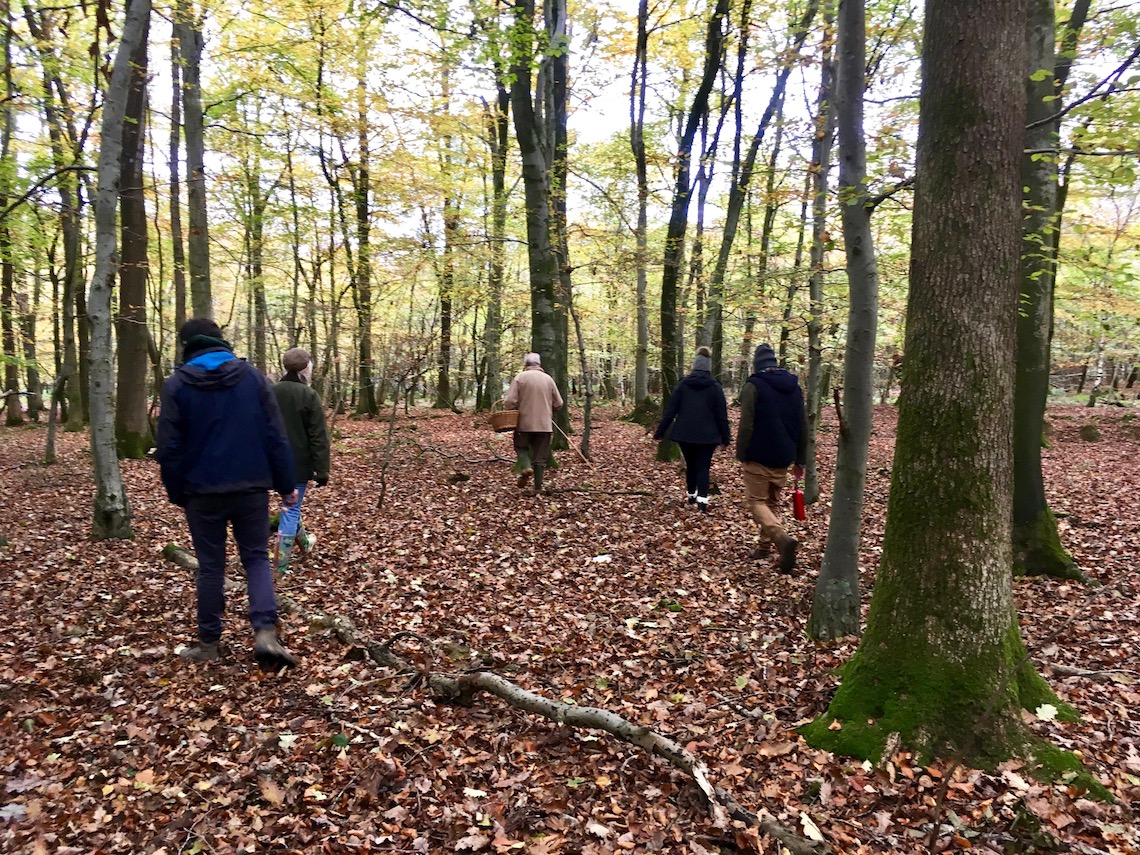
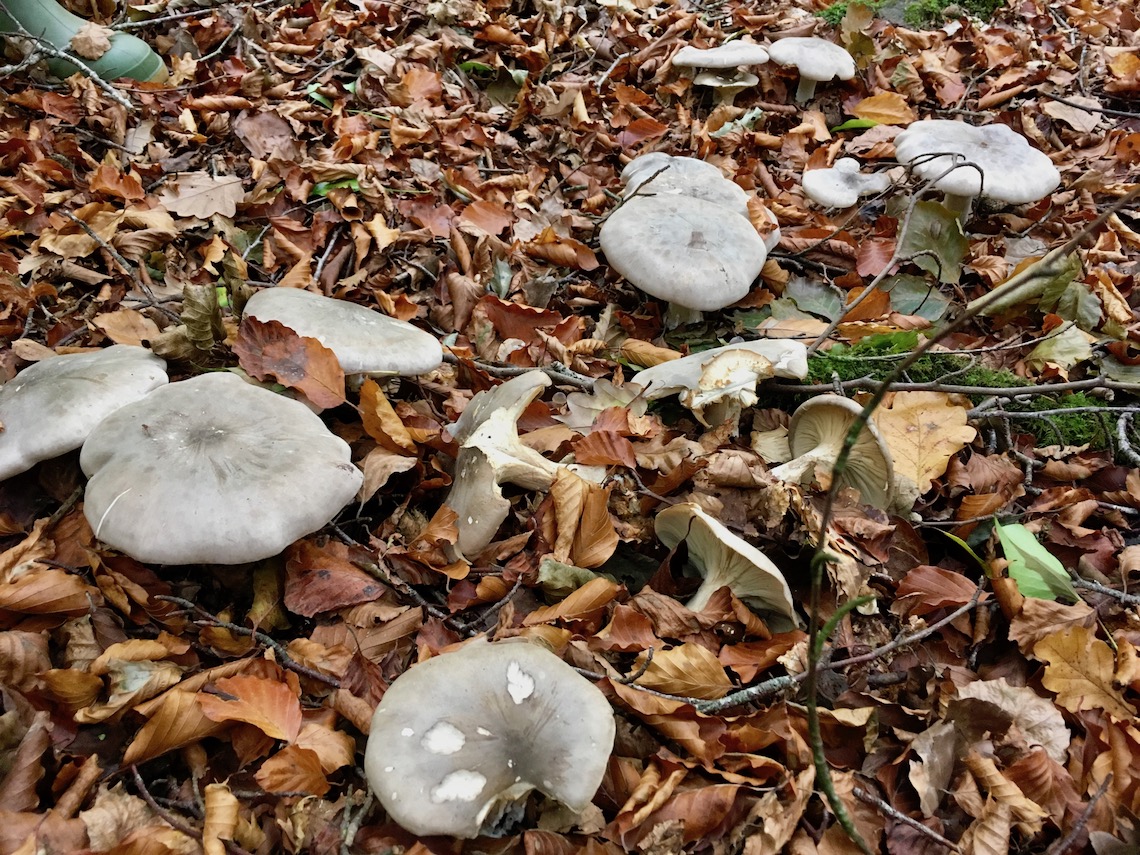
It felt like we were treasure hunting as we fanned out across the woodland. Raoul was looking for hedgehog mushrooms and came across some peeping up through the fallen leaves. These creamy, yellow fungi are unlike any I’d seen before. Turning one over in his hand, I could see the underside packed full of the spines that give these mushrooms their name. The appearance reminded me more of coral, than hedgehogs. It’s easy to brush away the soft spines with your finger, which you need to do before cooking.
Also called pied de mouton (in fancy restaurants), this mushroom has a sweet, nutty taste. It’s a good one for a novice forager to learn, as it’s really distinctive and hard to get wrong. We set to work gathering up the creamy hedgehogs and added our bounty to the basket.
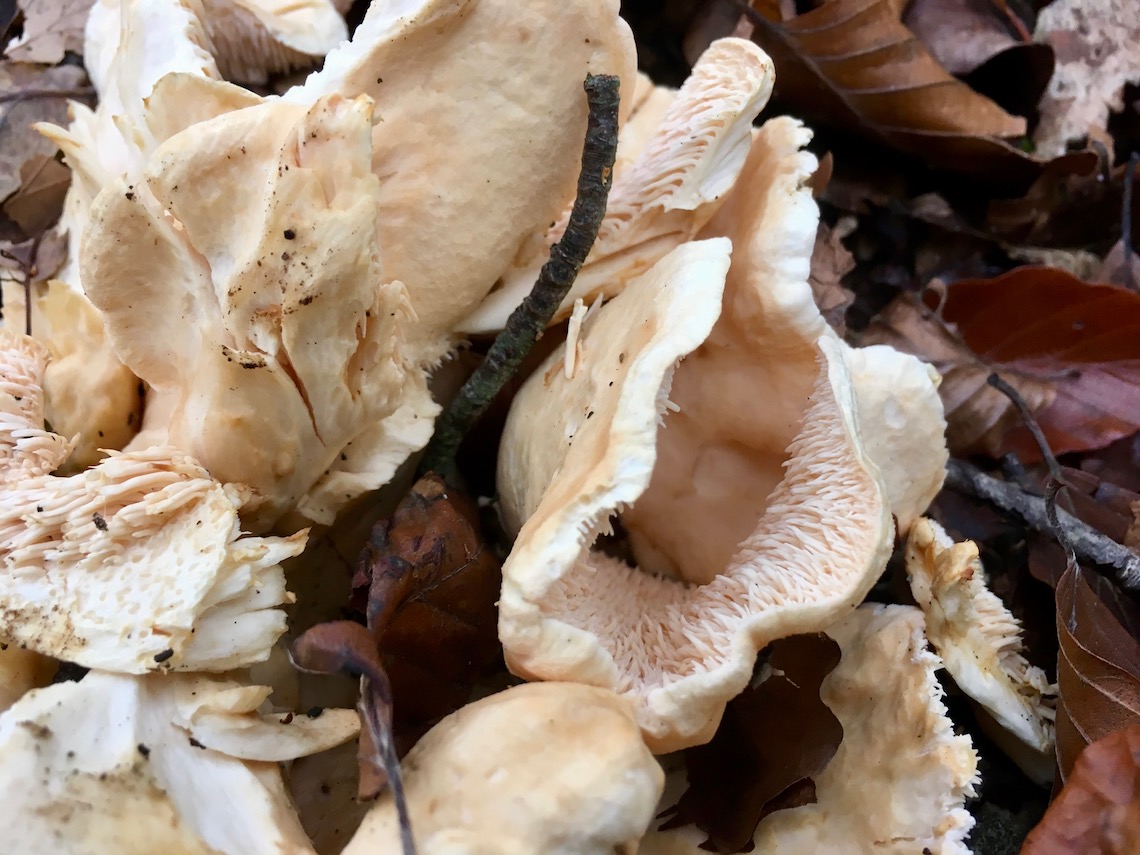
The next edible mushroom Raoul pointed out was an amethyst deceiver. These pretty, purple specimens are small and delicate looking. Their gills and velvety stalk are the same shade as the cap. I would have thought you should stay away from brightly coloured fungi, but it wasn’t the case with this particular treasure.
One of our group spotted a tiny patch of yellow mushrooms hiding amongst the leaves. Raoul identified them as yellow leg chanterelles, also known as winter chanterelles. Unlike some of the other mushrooms we’d found, these had concave caps and were camouflaged like brown leaves. But their distinctive yellow, indented stalks give them away. These have earned them the nickname ‘yellow legs.’ Chanterelles (called girolles in France) are one of the most popular with chefs, due to their fruity, yet peppery flavour.
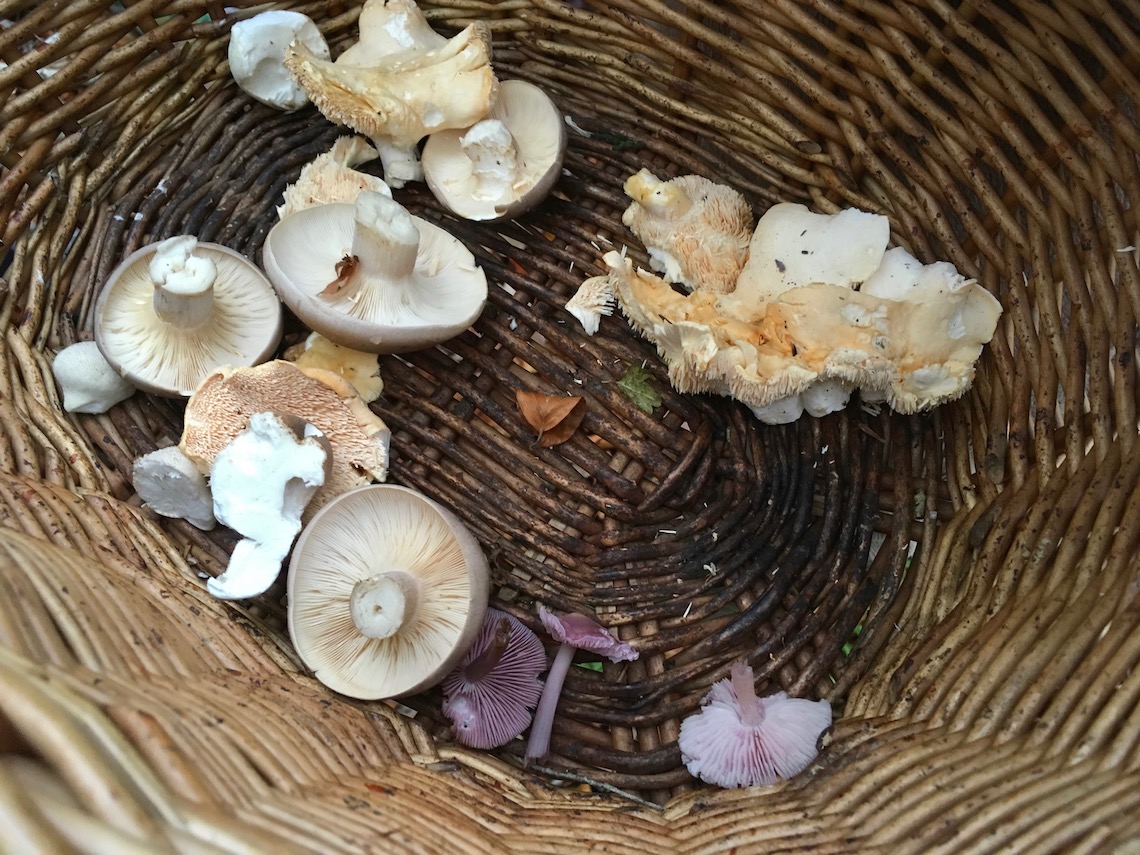
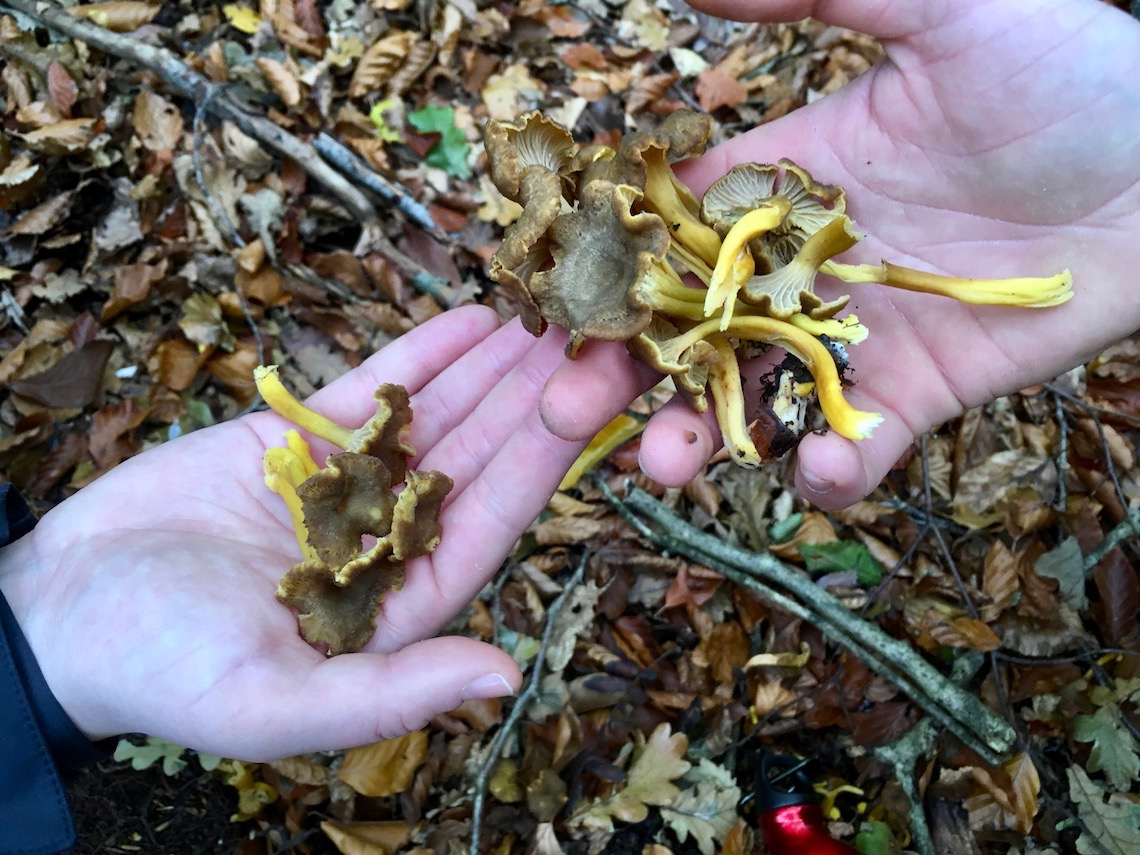
Raoul managed to identify the path to take us out of the wood and we began heading along it. He stopped and picked a strange looking mushroom. “Smell it,” he said, shoving it under a poor unsuspecting chap’s nose. This was a stinkhorn. It releases a foul smelling gel to attract flies in order to spread its spores. The Chinese use it as an aphrodisiac. You might understand why when you hear the mushroom’s Latin name ‘Phallus impudicus,’ translated as ‘shamelessly phallic!’
Our final foraged mushroom turned out to be a single wood blewit. This lilac-coloured convex cap covers a similar shade of gills and a fibrous, grey stalk. It’s supposed to be very tasty, but I wasn’t sure we’d get the chance to try it between ten people.
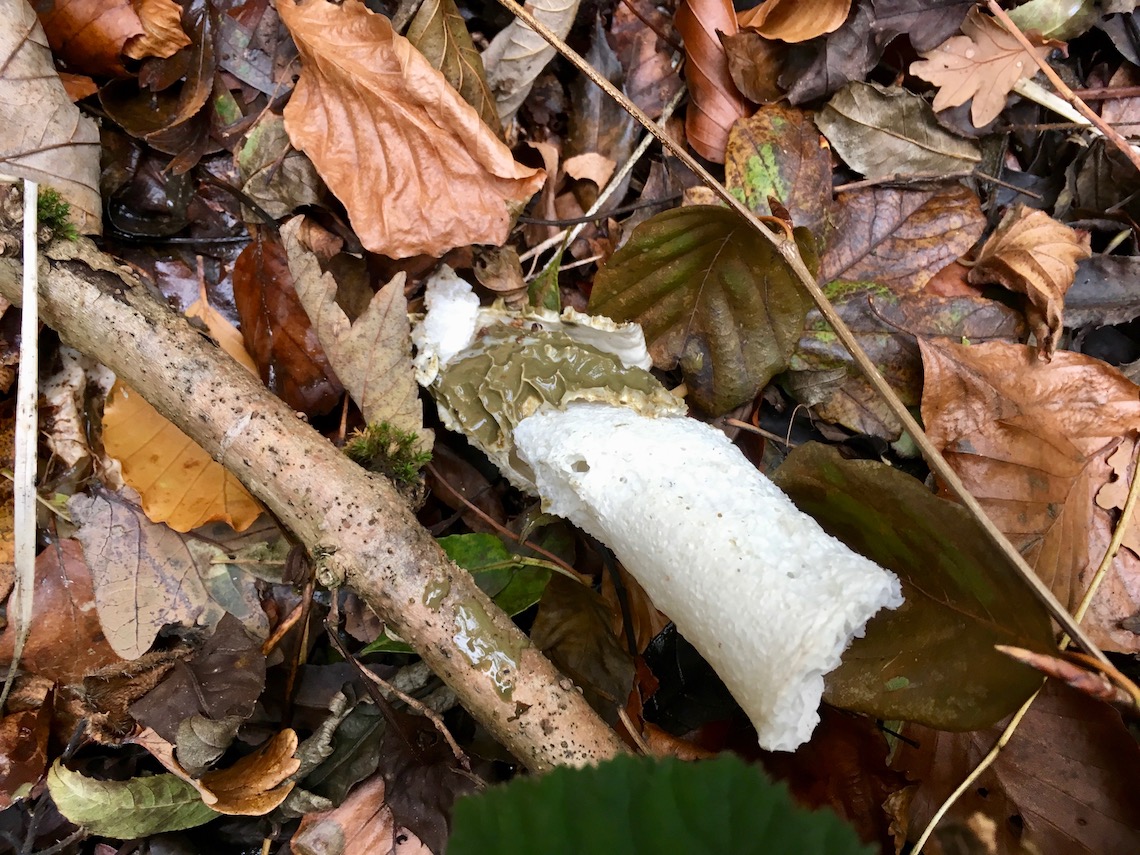
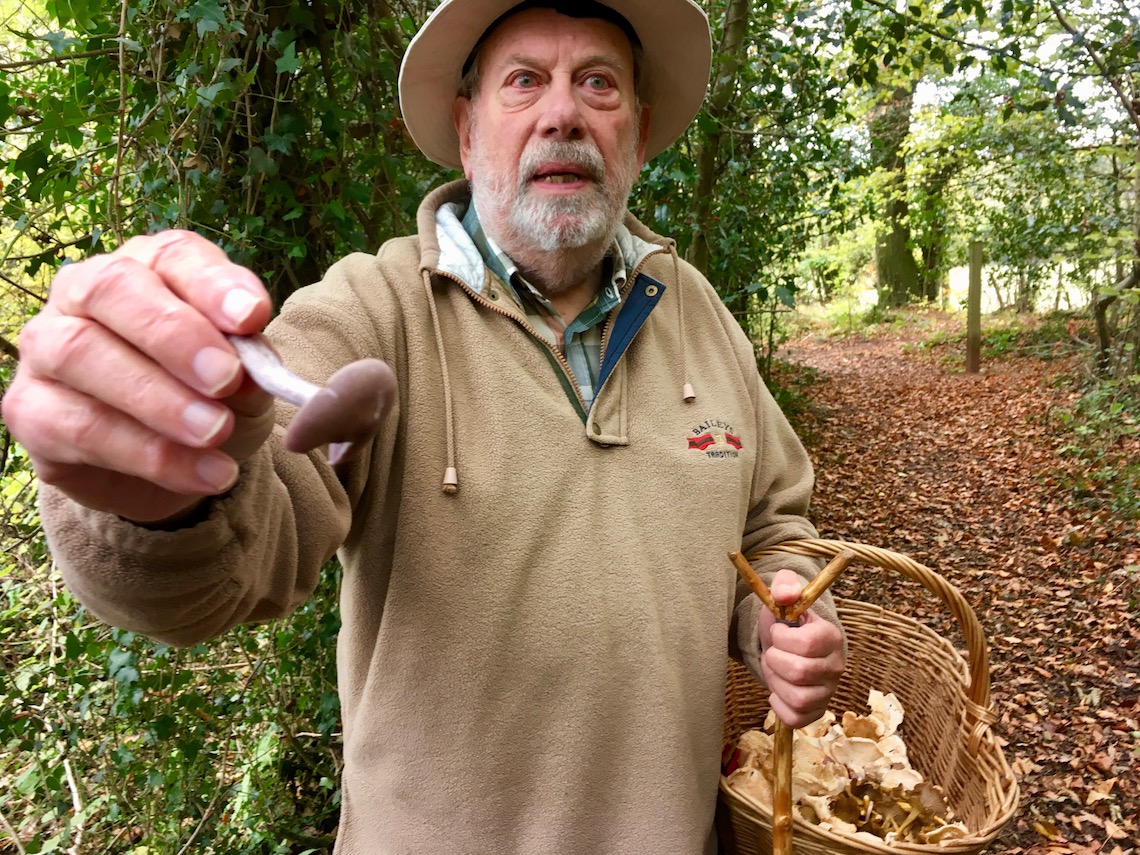
Illegal Digging
Our next stop was termed as ‘illegal digging.’ I tried using all my investigative journalism skills on Raoul to find out what we were up to, but he wouldn’t reveal it. We stopped by a campsite and headed up into a woodland, through a gate marked ‘Private – No Entry.’ He’d brought a shovel with him and asked for a volunteer to tell him where to plant it. I pointed to a spot under a tree and he began to dig.
Unearthing a tiny, white object, he gave it to me and said, “Try it.” Without thinking, I bit into it. My mouth was instantly filled with the pungent flavour of garlic. I wouldn’t normally choose to chew on a raw garlic clove, but this tasted slightly different. It was strong, but had the distinct flavour of wild garlic leaves. As there were no leaves in evidence, due to the time of year, it was a real surprise to find these bulbs hiding beneath the surface. There must have been hundreds of them.
Although Mr Skylark and I have previously foraged for wild garlic leaves, we’d never considered what the tiny wild garlic bulbs would look like, or that they were even edible. While this dig was perfect legal, because we had the landowner’s permission, it is illegal to dig them up in non-private woodland, hence Raoul’s term, ‘illegal digging.’
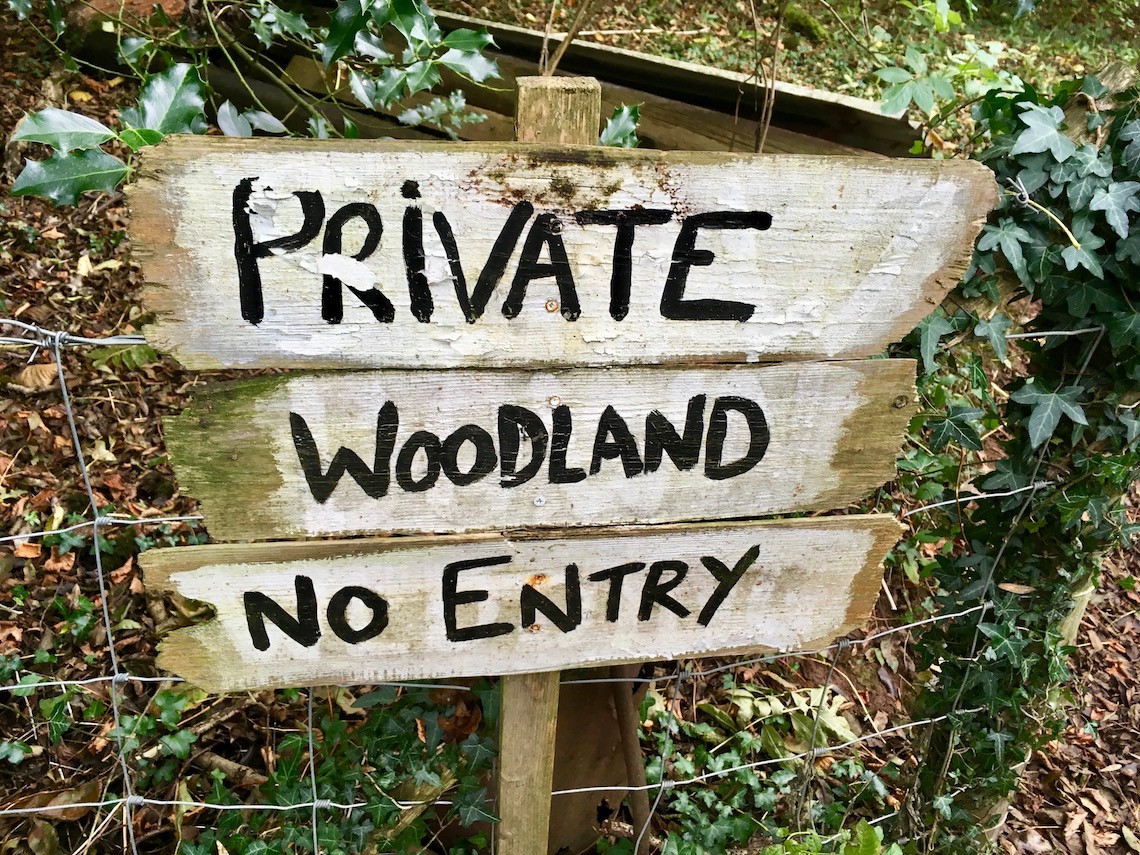
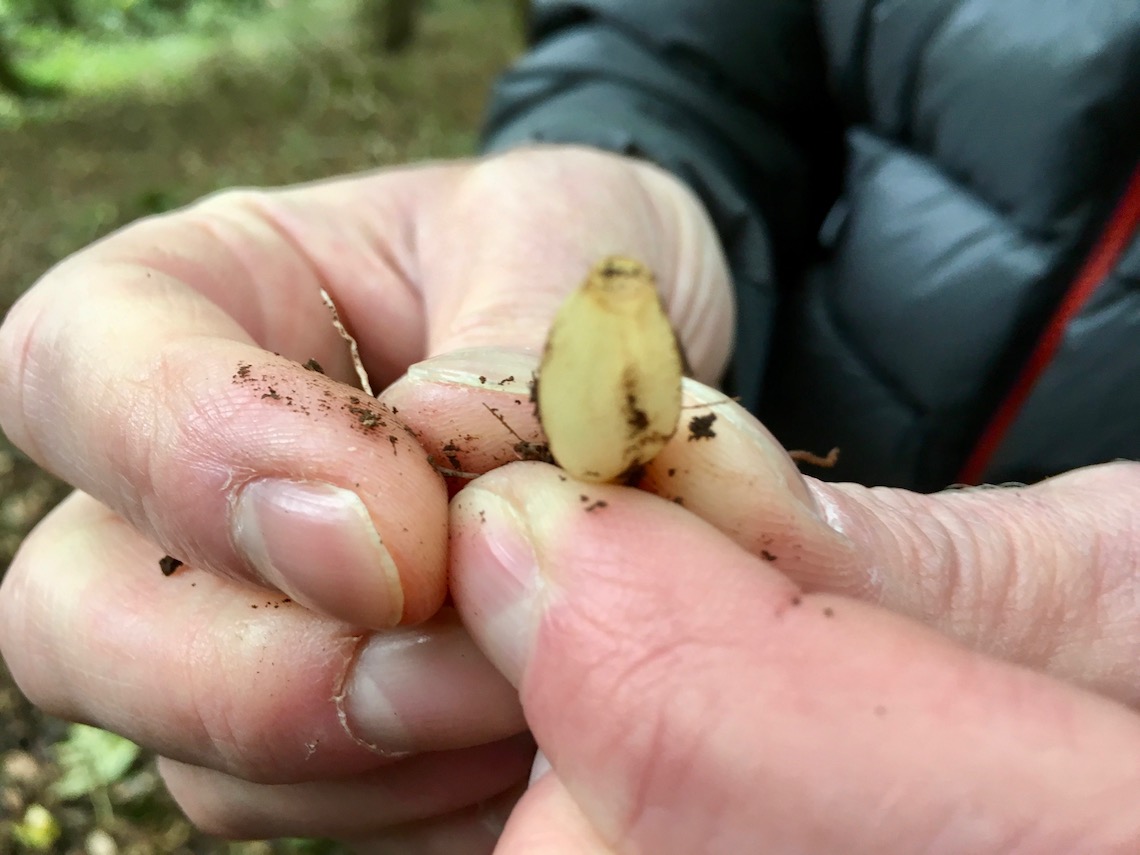
Foraging for Herbs and Berries
We drove onto the churchyard at Newland. I had been here before on my spring foraging trip, but this time we were here in search of something different. We stopped by a dark green yew tree and Raoul picked a bright red berry. He said, “They taste sweet like raspberry. But make sure you spit out the pips because are poisonous.” Like most people, I’d been brought up not to eat berries off a tree, but we all found ourselves plucking the yew berries. I couldn’t quite get raspberry, but it was sweet and surprising.
While we were standing by the tree, a young guy wandered by and stopped to speak to Raoul. “Look what I’ve found,” he said. “Is it edible?” He had a fine looking mushroom in his hand. “No, it’s no good,” Raoul answered. I felt gutted for this man who looked proud of what he’d found. But in this case, it was better safe than sorry. And also very lucky that he bumped into the local foraging expert before he took it home to eat.
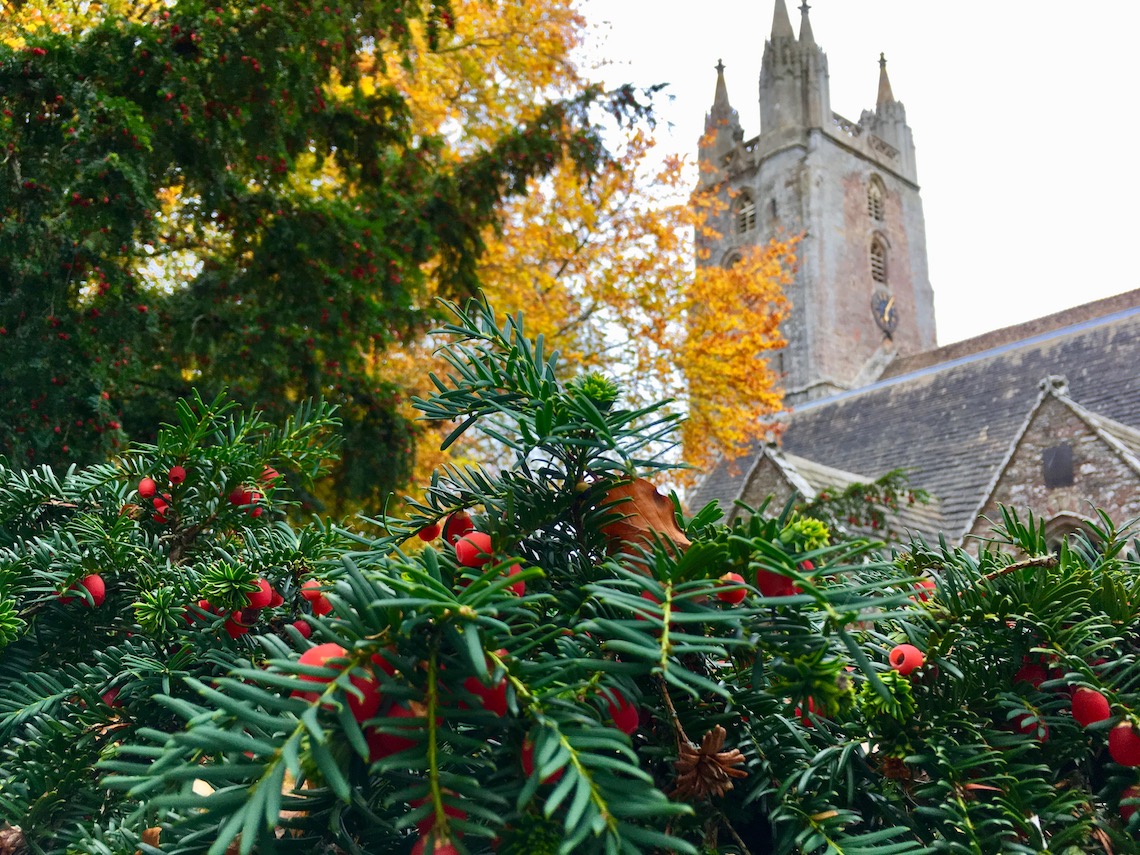
Heading down Savage Lane, our foraging guide was scouting out the roadside foliage. He eventually found what he was looking for: garlic mustard. I hadn’t come across this before, but the leaves and seeds are edible and have a garlicky, horseradishy flavour. Next he pointed out meadowsweet. This pretty flowering herb has long been used as a traditional medicine and had the lovely sweet smell of lemonade. Alongside it was a refreshing clump of spearmint that put me in mind of mojitos.
We crossed into a field and Raoul stopped to pluck something from the ground. He gave it to one of our group to taste. “What does it remind you of?” The answer was watercress, although it turned out to be hairy bitter cress. It’s something most of us will find in our gardens and ignore as a weed, but it actually has a lovely peppery flavour.
Our last stop was by a weed I recognised as Himalayan balsam. I already knew this non-native, invasive species is seen as a massive pest, but I had no idea you could eat it. Raoul told us the seeds are a delicious alternative to pine nuts. While this benefits the environment, as it stops the seeds from germinating, there is one word of caution: do not drop any or you will make matters worse!
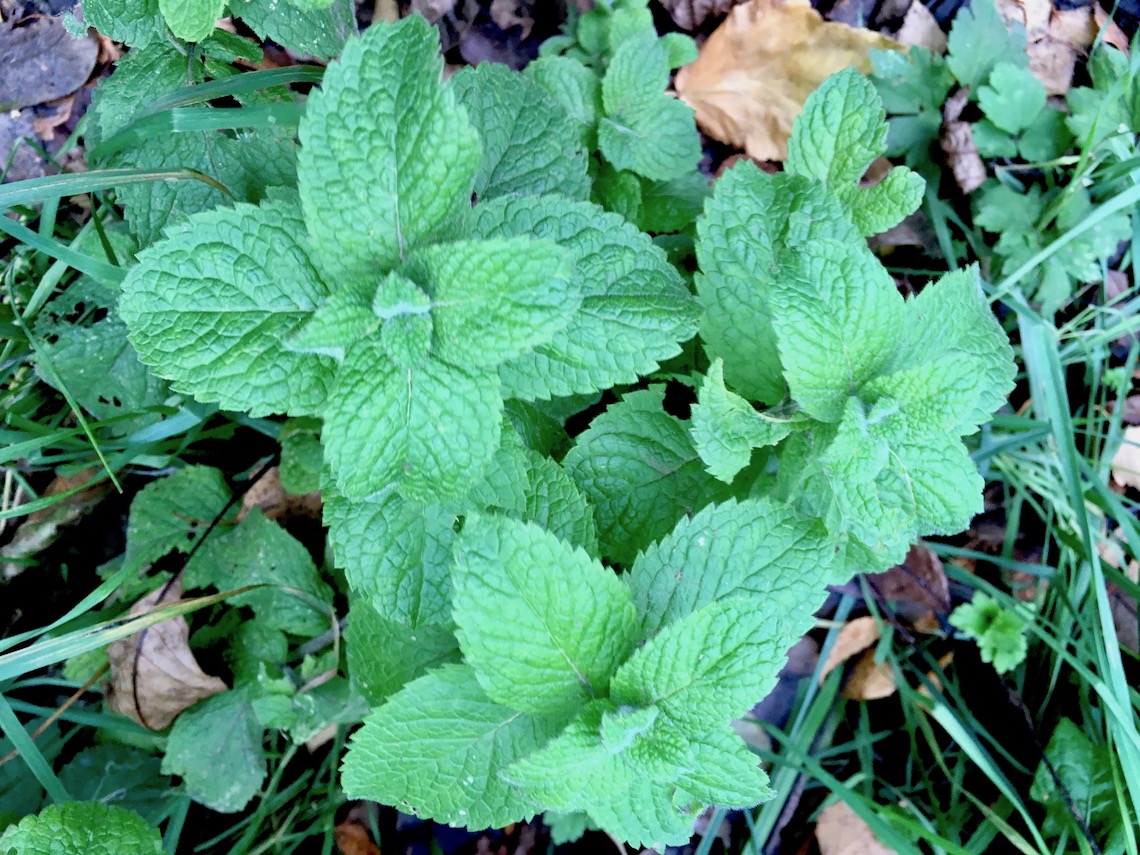
Foraging Lunch at Tudor Farmhouse
Back at Tudor Farmhouse, we shared most of the contents of the wicker basket between us to take home. The remaining mushrooms were sent to the kitchen to cook for us. Mr Skylark and I used our hedgehog and chanterelles haul to make a lovely risotto the following day.
We sat around a big table for lunch in the Farmhouse dining room. Raoul explained that he would try each type of the foraged mushrooms first to prove they were safe to eat. It wasn’t that he would keel over immediately anyway, but it demonstrates he eats what he picks and he’s still alive to tell the tale. Our mushroom collection had been simply pan fried in butter. Each had it’s own unique flavour and was truly delicious.
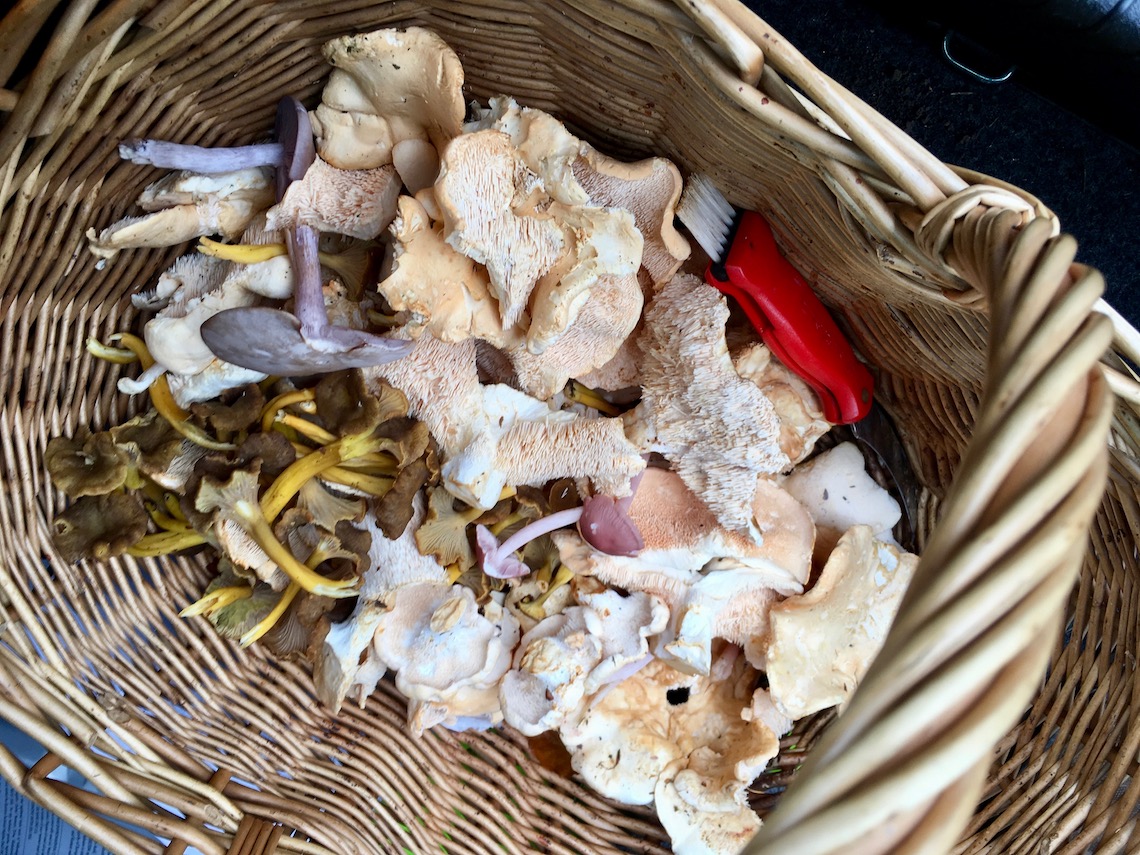
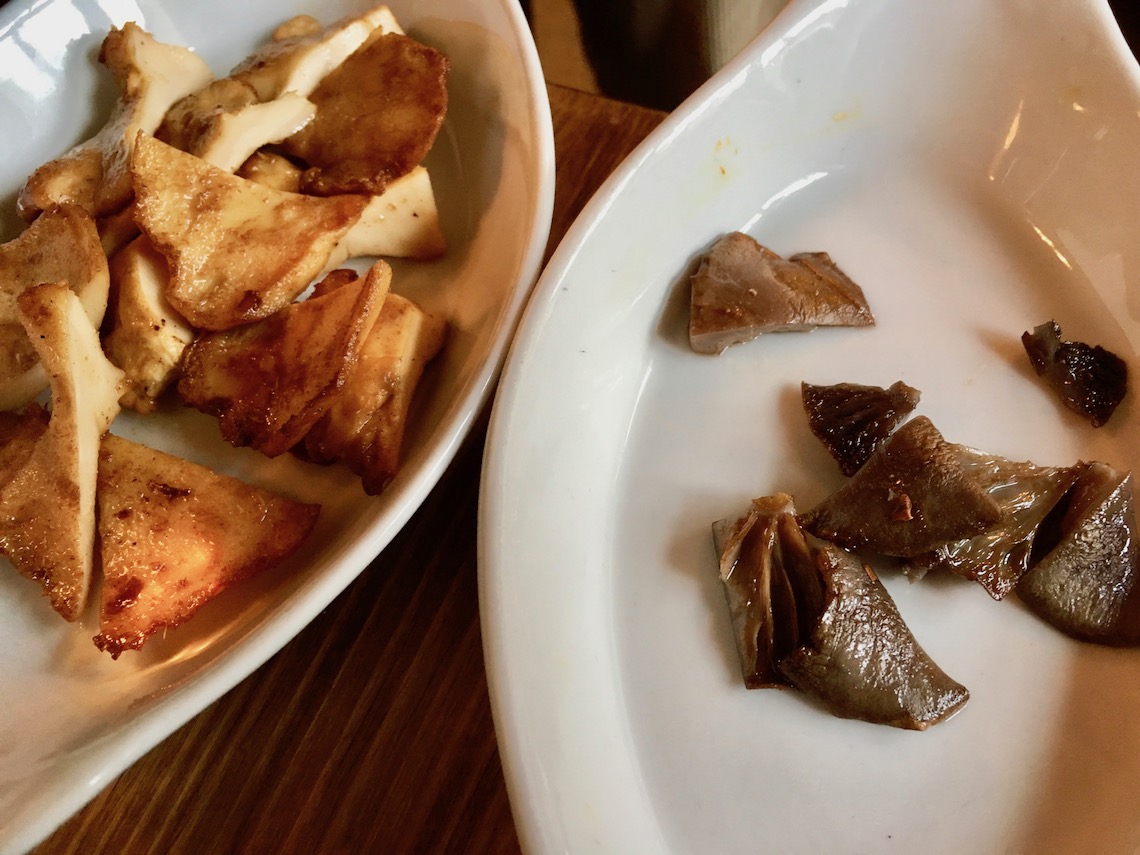
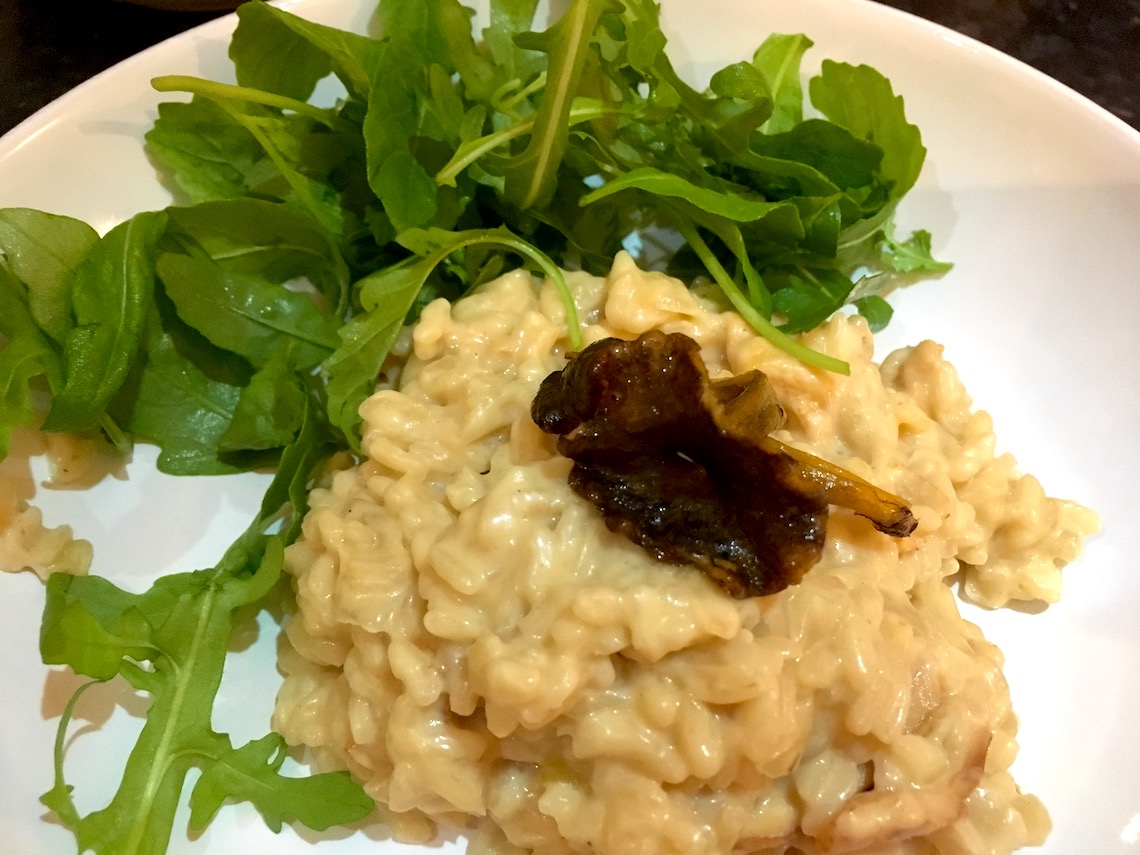
Our own foraged mushroom tasting was followed by chanterelle soup. It was rich, silky and creamy and had been drizzled with tarragon oil and sprinkled with toasted hazelnuts, which gave a lovely crunch. The main course was my favourite: two pieces of grilled plaice sitting on top of crushed new potatoes and salty samphire. The plaice melted in the mouth and was surrounded by a frothing mussel veloute. The dessert was small, but perfectly sized (for me). The sweet cheesecake mousse was accompanied by tangy apple and topped with granola and had a light rosemary scent.
All Mr Skylark and I had to worry about now was to make sure we’d left enough room for dinner and check in to our room for an overnight stay (new blog post coming soon).
While I had hoped we would learn enough to go out on our own mushroom foraging trips, the words left ringing in my ears were, “The rule about picking mushrooms is there are no rules.” But if I ever spot a hedgehog mushroom, I think I’d be confident enough to give it a try.
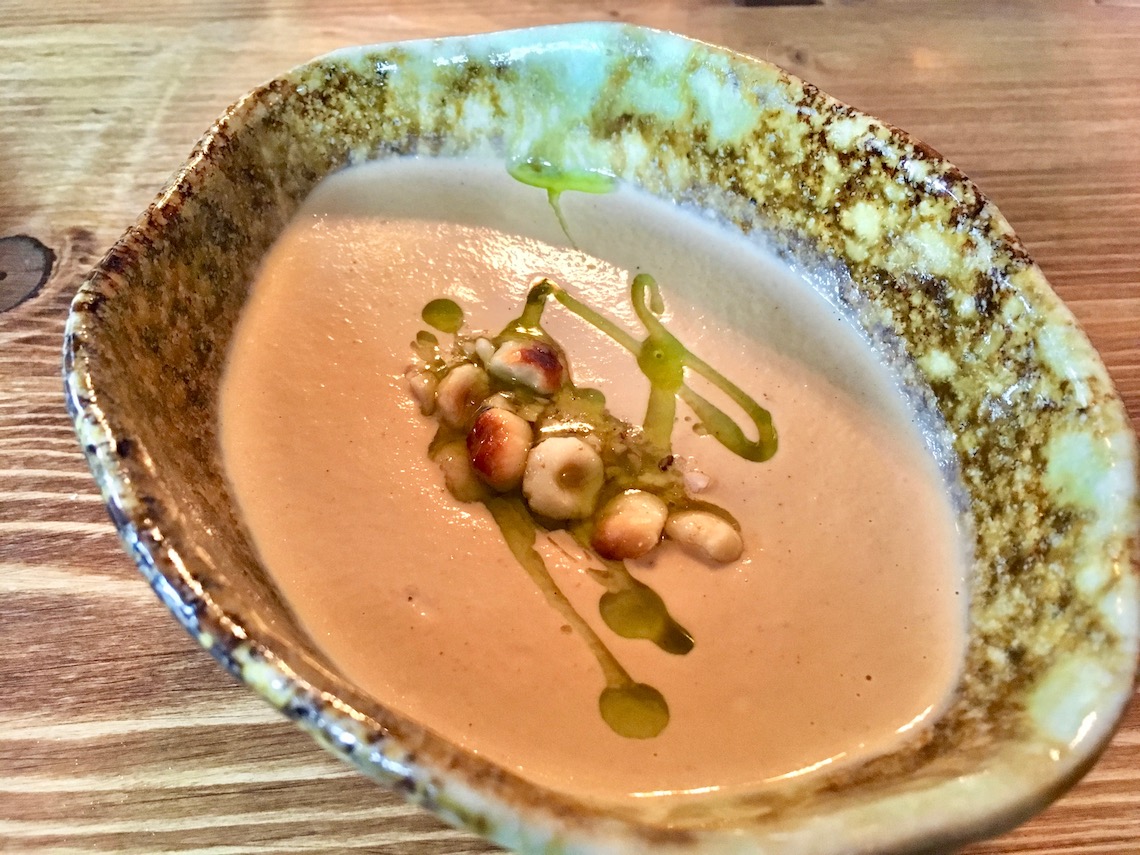
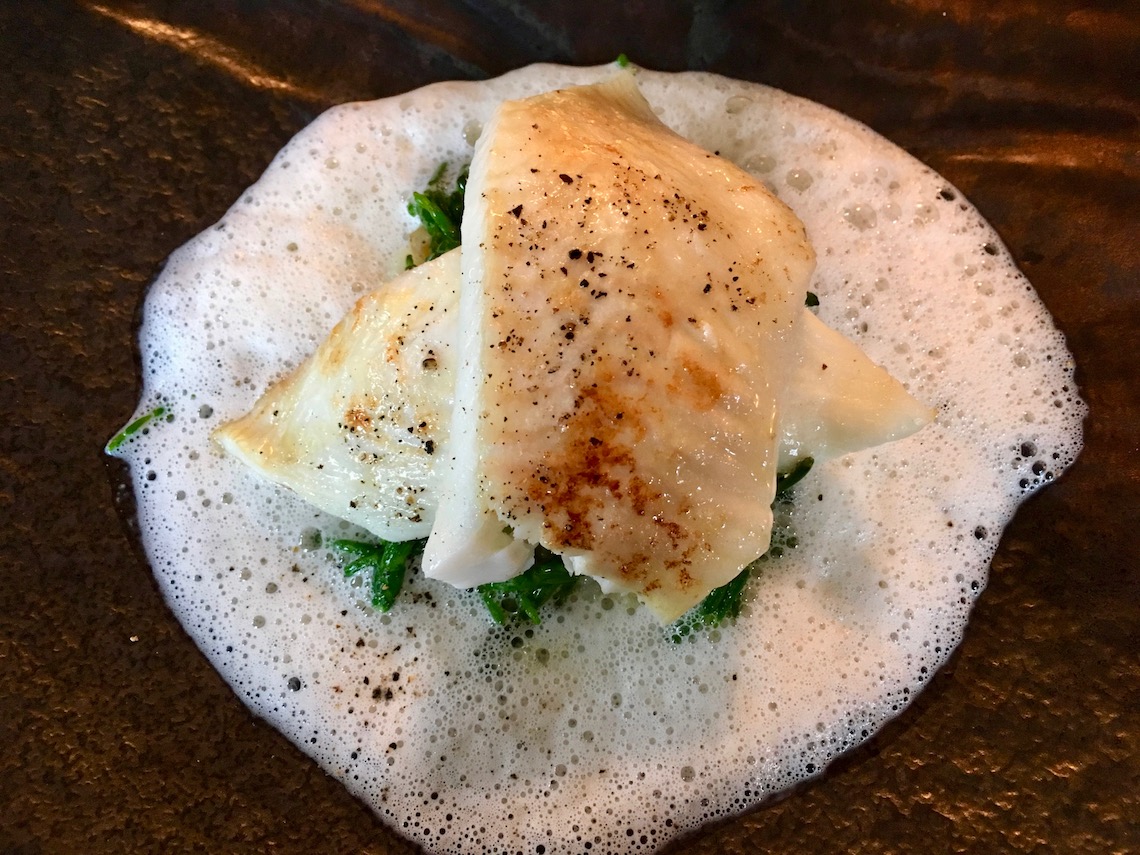
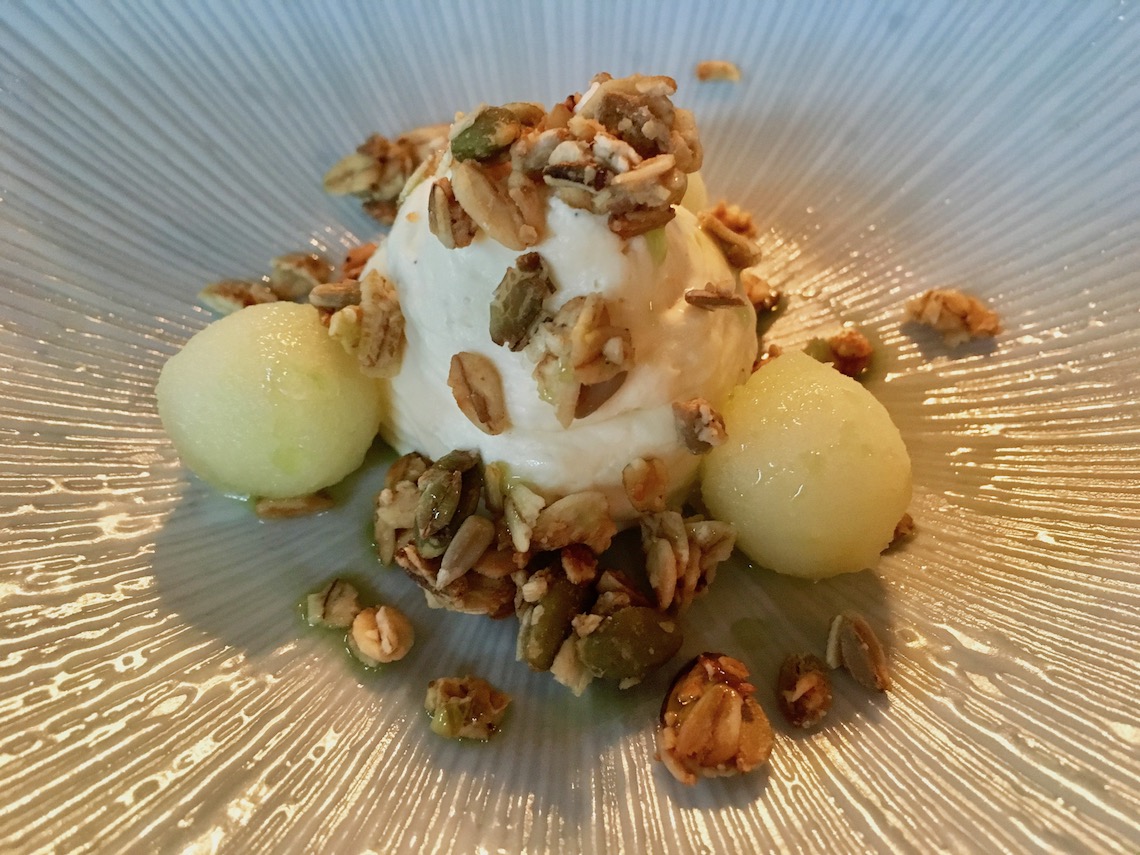
Word of Caution: Don’t eat plants or fungi you are not familiar with, some are incredibly toxic. Learn from an expert guide.
Thank you to Tudor Farmhouse for kindly hosting my visit. All views and opinions are my own.
Group foraging trips at Tudor Farmhouse with Raoul van den Broucke run in the spring and autumn, starting from £60 per person including lunch. Private foraging trips are also available.
Read about my springtime foraging visit.
Have you had any experiences of foraging? I’d love to hear about them in the comments below.

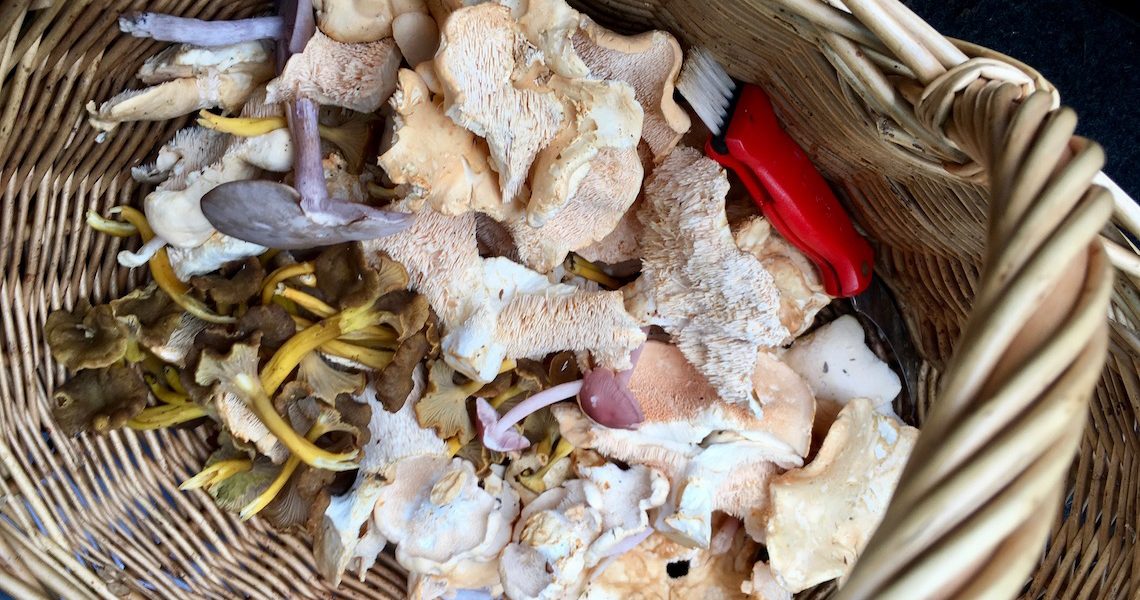
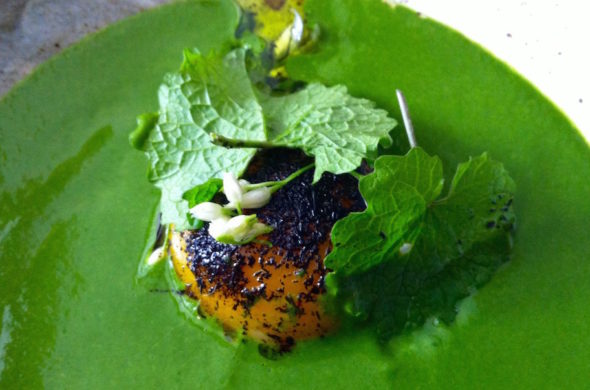
Larch Gauld
November 27, 2018I have wanted to go foraging for years but never seem to be in the right place at the right time! The Forest of Dean is reasonably close, so I will get in contact with The Tudor Farmhouse and see if I can arrange a visit. Thank you Sara!
Skylark
November 28, 2018I most definitely recommend Tudor Farmhouse for their foraging experiences. If you have the chance to really spoil yourself, you should stay over. It’s lovely!
Kim
November 27, 2018Great post, it sounds like you were given a real treat of Raoul’s knowledge, my mum is a keen forager but unless it’s blackberries I don’t delve! Great you’ve covered the legal aspect as many people don’t realise that you have to obtain permission of the landowner to forage.
Skylark
November 28, 2018Thanks Kim! I’m curious to know what your Mum forages. Is she brave enough to pick mushrooms? I was more surprised to learn that you can’t dig in woodland generally. Always best to get permission wherever you are, just in case.
Danielle
November 27, 2018What a fascinating day foraging! I always wish I knew more and was confident in identifying mushrooms but far better to go with an expert!
Skylark
November 28, 2018Hi Danielle. It was really fascinating. I’d definitely recommend heading out with an expert like Raoul. He has years and years of experience!
Danni
November 28, 2018Sounds like a fab day and such a useful skill to have!! I’ve never done anything like it!
Skylark
November 28, 2018Hi Dani. It was brilliant and really useful, but I will definitely be careful before I attempt picking mushrooms myself!